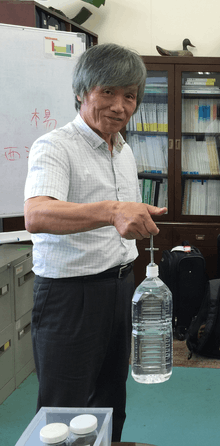Masato Sagawa
| Masato Sagawa 佐川眞人 | |
|---|---|
 | |
| Born |
August 3, 1943 Tokushima, Japan |
| Fields | Metallurgy, Magnetic Materials, Sustainable energy |
| Alma mater | Kobe University (B.A.) (M.S.) Tohoku University (Doctor Eng.) |
| Notable awards |
Asahi Prize (1990) Japan Prize (2012) |
| Spouse | Hisako Sagawa 久子 |
Masato Sagawa (佐川眞人; born August 3, 1943 in Tokushima, Japan) is a Japanese scientist and entrepreneur, and the inventor of sintered permanent magnet NdFeB. Sagawa was awarded the Japan Prize in 2012 for inventing and developing the highest performing sintered Nd-Fe-B type permanent magnets and contributing to energy conservation.[1][2][3] Dr. Sagawa is the president of NDFEB Corporation at Kyoto, Japan.
Early life and education
Masato Sagawa was born in Tokushima Prefecture, Japan in August 3, 1943. Masato Sagawa graduated from Amagasaki City High School in 1961. He received his B.A. from Kobe University in 1966, his M.S from Kobe University in 1968, and his Doctorate degree from Tohoku University in 1972.
Career
The sintered NdFeB was initially conceived and developed by Sagawa when he was with Fujitsu Laboratories where he worked from 1972–1982. Without his supervisor’s support for the new magnetic compound, Sagawa resigned in 1981, and then joined Sumitomo Special Metals. Within several months after joining Sumitomo Special Metals in 1982, the strongest sintered NdFeB magnet was developed. Dr. Sagawa presented the new discovery of NdFeB magnet during the Magnetism and Magnetic Materials Conference in Nov. 1983 in Pittsburgh, Pennsylvania.[2][4] In 1988, Sagawa founded Intermetallics, a research and development company devoted to the development of neodymium magnets.[3][5][6] Dr. Sagawa founded NDFEB Corporation in 2012 and he is the president of NDFEB Corporation at Kyoto, Japan.

Major awards and honors
- Osaka Prize (1984)
- Minister of Science and Technology Agency Award (1985)
- James C. McGroddy Prize for New Materials (1986)
- Asahi Prize (1990)
- Japan Magnetics Society Award (1991)
- / Okochi Memorial Prize (1993)
- / Acta Metallurgica J. Herbert Hollomon Award (1998)
- Honda-kinen Prize (2003)
- Kato-kinen Prize (2006)
- Japan Prize (2012)[1][5]
References
- 1 2 "Laureates of the Japan Prize: Masato Sagawa, Dr. Eng.". The Japan Prize Foundation. Retrieved 29 July 2015.
- 1 2 Sagawa, M.; Fujimura, S.; Togawa, N.; Yamamoto, H.; Matsuura, Y. (1984). "New material for permanent magnets on a base of Nd and Fe (invited)". Journal of Applied Physics. 55 (6). doi:10.1063/1.333572.
- 1 2 Gutfleisch, Oliver; Willard, Matthew A.; Brück, Ekkes; Chen, Christina H.; Sankar, S. G.; Liu, J. Ping (15 February 2011). "Magnetic Materials and Devices for the 21st Century: Stronger, Lighter, and More Energy Efficient". Advanced Materials. 23 (7): 821–842. doi:10.1002/adma.201002180.
- ↑ Sagawa, M.; Fujimura, S.; Yamamoto, H.; Matsuura, Y.; Hiraga, K. (September 1984). "Permanent magnet materials based on the rare earth-iron-boron tetragonal compounds". IEEE Transactions on Magnetics. 20 (5): 1584–1589. doi:10.1109/TMAG.1984.1063214.
- 1 2 "Achievement : Developing the world’s highest performing Nd-Fe-B type permanent magnet and contributing to energy conservation" (PDF). The Japan Prize Foundation. Retrieved 29 July 2015.
- ↑ "Changing the EV and the World with the Motor". Mitsubishi Corp. Retrieved 29 July 2015.
External links
- Speech at Tohoku University on Jan 27, 2014
- History of Rare Earth Magnets
- 2012 (28th) Japan Prize: Dr. Sagawa
- 2012 Japan Prize Commemorative Lectures : Dr. Sagawa
- / Laureates of the Japan Prize: Masato Sagawa, Dr. Eng.
- / Inventing the Sintered NdFeB Magnets
- / Japan Prize Press Room